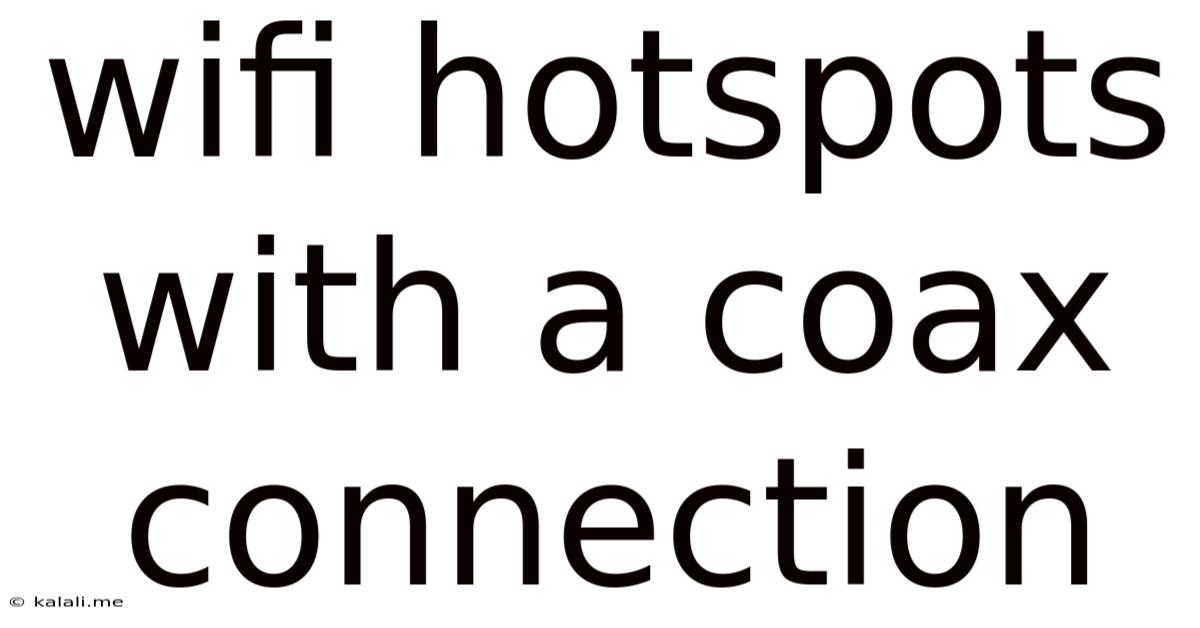Wifi Hotspots With A Coax Connection
Kalali
Jun 11, 2025 · 3 min read

Table of Contents
Unleashing the Power of Your Coax: Using WiFi Hotspots with a Coax Connection
Are you looking to expand your internet coverage and create a robust WiFi network, but your existing infrastructure relies on a coaxial cable connection? You're not alone! Many homes and businesses utilize coax cables for their primary internet connection, and thankfully, bridging the gap between coax and WiFi is easier than you might think. This article explores various methods for creating powerful WiFi hotspots using a coax connection, examining their pros and cons to help you choose the best solution for your needs.
Why Use Coax for WiFi?
Coaxial cables, often referred to as coax cables, offer several advantages for internet connectivity:
- Existing Infrastructure: Many homes already have extensive coax cabling installed, eliminating the need for extensive new wiring.
- Long Distances: Coax cables can transmit data over longer distances with less signal degradation compared to Ethernet cables.
- Cost-Effective: Utilizing existing coax infrastructure can significantly reduce the overall cost of expanding your WiFi network.
- Broadband Capabilities: Coax cables are capable of carrying high-bandwidth internet signals, suitable for streaming, gaming, and other bandwidth-intensive applications.
Methods for Creating WiFi Hotspots with a Coax Connection:
Several methods allow you to leverage your existing coax infrastructure for a WiFi network:
1. Using a Coax-to-Ethernet Adapter and a WiFi Router:
This is perhaps the simplest and most common method. A coax-to-Ethernet adapter converts the coax signal into an Ethernet signal, which can then be connected to a traditional WiFi router. This setup provides a reliable and straightforward solution for homes with existing cable internet service.
- Pros: Relatively inexpensive, easy to set up, widely available.
- Cons: Requires a separate WiFi router, potential signal degradation depending on the quality of the adapter and cabling.
2. MoCA Adapters for a Wired Network:
Multimedia over Coax Alliance (MoCA) adapters utilize the existing coax infrastructure to create a high-speed wired network. You connect a MoCA adapter to your modem and another to your router, creating a wired connection between them. This solution is ideal for situations where wireless signals are weak or unreliable. Then, your router broadcasts your WiFi network.
- Pros: High speeds, reliable connection, ideal for hard-to-reach areas.
- Cons: Requires purchasing multiple MoCA adapters, slightly more complex setup compared to a coax-to-Ethernet adapter.
3. Using a DOCSIS 3.1 Cable Modem with Built-in WiFi:
Many modern cable modems support DOCSIS 3.1 technology and include integrated WiFi capabilities. This eliminates the need for a separate router, simplifying setup and potentially saving cost.
- Pros: Simplified setup, often cost-effective, built-in features.
- Cons: May require a more expensive cable modem, less flexibility in router customization.
4. Mesh WiFi Systems with Coax Connectivity (Indirect Method):
While not directly using coax for WiFi transmission, some advanced mesh WiFi systems can integrate with your existing coax network indirectly. For example, you could connect a mesh node via Ethernet to a point on the coax network (using a coax-to-Ethernet adapter), extending the range and coverage of your mesh network.
- Pros: Excellent range and coverage, self-healing network, advanced features.
- Cons: More expensive than basic solutions, requires more setup and planning.
Choosing the Right Solution:
The best method for creating a WiFi hotspot with a coax connection depends on your specific needs and budget. Consider factors such as:
- Budget: Coax-to-Ethernet adapters are the most affordable option, while mesh WiFi systems are the most expensive.
- Technical Skill: Simple coax-to-Ethernet setups are easy to implement, while MoCA and mesh networks require a bit more technical knowledge.
- Network Size and Coverage: For larger homes or areas with poor WiFi penetration, MoCA or mesh WiFi may be necessary.
- Speed Requirements: MoCA generally provides faster speeds compared to coax-to-Ethernet adapters.
By carefully weighing these factors, you can select the optimal solution to transform your existing coax infrastructure into a robust and reliable WiFi network, enhancing your home or office connectivity. Remember to consult your internet service provider if you encounter any difficulties.
Latest Posts
Latest Posts
-
How Many Slices Of Turkey In 2 Oz
Jul 01, 2025
-
Omnipoint Miami E License Llc Miami Fl
Jul 01, 2025
-
Mi Familia Fuera La M S Grande Correct Incorrect
Jul 01, 2025
-
How Much Is 20 Pounds Of Pennies Worth
Jul 01, 2025
-
How Much Does A Gallon Oil Weigh
Jul 01, 2025
Related Post
Thank you for visiting our website which covers about Wifi Hotspots With A Coax Connection . We hope the information provided has been useful to you. Feel free to contact us if you have any questions or need further assistance. See you next time and don't miss to bookmark.